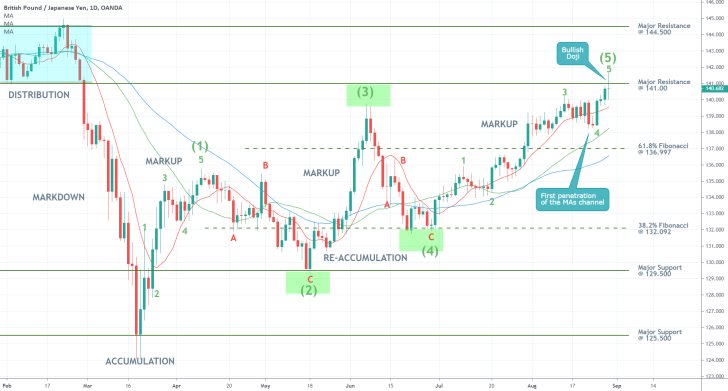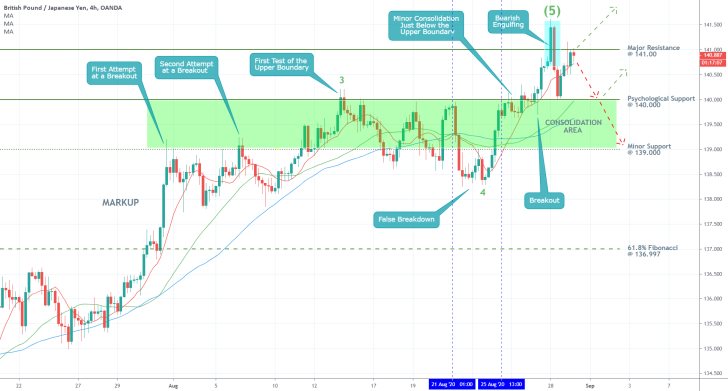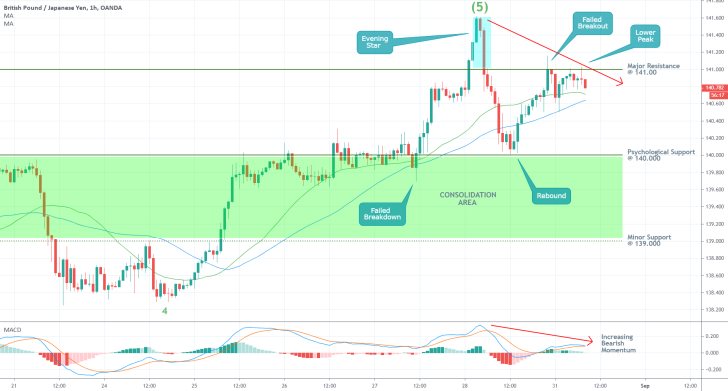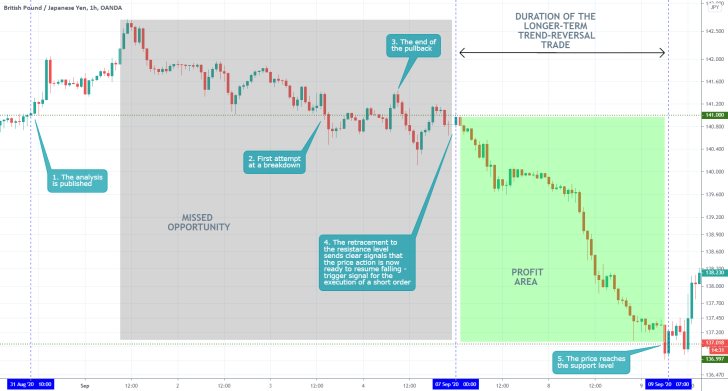The substantial bullish run of the British pound over the last several weeks drove the pair above the psychologically significant threshold of 140.00. This level, which had previously served the role of a major support, was last broken prior to the beginning of the market crash that was triggered in the early days of the coronavirus crisis.
Even though this represents a significant accomplishment for the bulls, the continuation of the rally is far from certain. The price action continues to be testing the area around the aforementioned level, and there is mounting evidence in the short-term, suggesting a likely reversal in the near future.
With regards to the underlying economic factors in the UK, the recent hike of the pound seems counterintuitive. The uptrend continued even when it was reported that the British economy had contracted by more than 20 per cent in the second quarter.
The bullish run of the GBPJPY can, therefore, be largely attributed to speculative trading. Two major factors supported it - the recent downturn of the euro coupled with the attempts of the dollar to recoup its losses from the beginning of the summer.
The market would eventually start to price in the weak data coming in from the UK, which would jeopardise the strengthening of the sterling. Meanwhile, the demand for the yen is likely to jump in the following months due to investors' fears of a second downturn of the global economy, and a second coronavirus wave. This is due to the status of the yen as a safe-haven currency.
That is why today's analysis examines these fundamental factors in line with the current technical outlook of the GBPJPY and studies the possibility for a forthcoming trend reversal.
1. Long-Term Outlook:
As per usual, the Elliott Wave Theory can be used when examining the strength and structure of a broad trend. As can be seen on the daily chart below, the bullish run that was initiated in the wake of the initial coronavirus hit - at the lowest point of the Accumulation range – appears to have established a massive 1-5 impulse wave pattern. The latter, in turn, is comprised of smaller 1-5 patterns and corrective ABC patterns. Each one of these smaller patterns represents either an impulse or a retracement leg of the broader (1)-(5) pattern.
The apparent termination of this broader (1)-(5) pattern represents one of the most significant pieces of evidence signalling the likely formation of a bearish correction in the near future. Moreover, this termination appears to have happened just below the major resistance level at 141.00, which served as the lower boundary of the last Distribution range.
Because of its previous role as a major support level, the resistance at 141.00 represents a very probable turning point for the underlying direction of the GBPJPY. The development of a new downturn on the GBPJPY becomes more probable when these two pieces of evidence are examined together.

Nevertheless, bears should be cautious. The underlying market sentiment remains ostensibly bullish, as demonstrated by the three moving averages. The price action is concentrated above the 10-day MA (in red), which is trading above the 30-day MA (in green). The latter is, in turn, positioned above the 50-day MA (in blue). This ascending order of the four illustrates the robust bullish bias in the market.
Each one of the three MAs represents a floating support, and is, therefore, a potential turning point for any bearish correction/trend. Notice that the price action has barely tested the possibility of breaking down below the 10-day MA, which was followed by a snap rebound. Hence, the bears should prepare for a potentially protracted transition of the market from having an ostensibly bullish to prevailingly bearish sentiment.
2. Short-Term Outlook:
Understanding the behaviour of the price action around the psychologically significant level at 140.00 would shed light on the next direction of the pair. As can be seen on the 4H chart below, the price action initially consolidated just below the resistance – the area in green – after managing to break out above it. The uptrend was then continued with a temporary breakout above the aforementioned resistance at 141.00.
A significant indication of the currently waning bullish commitment is the fact that a snap rebound immediately followed this breakout. The resulting bearish engulfing pattern represents the first major step in the likely emergence of a new bearish correction/downtrend. The first two target-levels for such a downswing are encapsulated by the 140.00 support and the lower limit of the consolidation area at 139.00, respectively.
However, there is also a slim chance for the price action to continue rising. This will be confirmed if the pair manages to break out above the 141.00 resistance decisively. This possibility is highlighted by the fact that the price action of the GBPJPY remains concentrated above the three aforementioned MAs in the short term as well.
The last time the price action attempted to break this ascending order of the MAs was in the period between the 21st and the 25th of August. The attempt came to no avail as the price action rebounded promptly after the initial breakdown. Hence, the market bears should remain vigilant even if the pair manages to do the same in the near future.

Moving on to the hourly chart below, the MACD indicator confirms the gradually rising bearish momentum in the short-term. Accordingly, the price action has failed to break out above the major resistance at 141.00 on two separate occasions since last Friday and has thus established consecutively lower peaks.
This allows us to draw a descending trend line, which outlines the currently evolving reversal. In other words, if the price action does not break out above this trend line in the near future, there would be enough time for the accumulation of even more bearish pressure.
Finally, the Evening start pattern and the failed breakouts above the 141.00 level represent two additional pieces of evidence signalling the falling bullish commitment in the market, which is a necessary factor for the development of a new bearish correction/downtrend.

3. Concluding Remarks:
The behaviour of GBPJPY's price action around the crucially important resistance level at 141.00 is congruent with the assertions drawn from the observed fundamental factors. The pair is likely to depreciate in the following days and weeks; however, the termination of the recent bullish trend is unlikely to happen in an instance.
Rather, the transition of the market from being mostly bullish-oriented towards having a predominantly bearish bias would likely be marked by sporadic fluctuations of the price action. So, expect the appearances of sudden volatility outbursts in both directions to intensify before the price action starts dropping further down south.

- The longer-term projections of the analysis were mostly realised, but the lack of accuracy of the shorter-term projections impeded the overall performance of the trade. It was good that the analysis stressed on the likely lengthiness of the transition period in the market – from concluding the previous trend to establishing the new downtrend.
Disclaimer: Your capital is at risk! Trading and investing on the financial markets carries a significant risk of loss. Each material, shown on this website, is provided for educational purposes only. A perfect, 100% accurate method of analysis does not exist. If you make a decision to trade or invest, based on the information from this website, you will be doing it at your own risk. Under no circumstances is Trendsharks responsible for any capital losses or damages you might suffer, while using the company’s products and services. For more information read our Terms & Conditions and Risk Disclaimer.





















